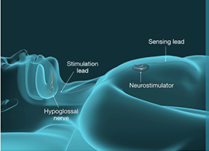The “Spotlight on CPT” is shining on drug-induced sleep endoscopy (DISE) for this month. DISE is a procedure performed on patients who are diagnosed with obstructive sleep apnea. The goal is to establish exactly how and where the breathing is being obstructed and thus determine what type, if any, surgical procedure would be beneficial.
With the CPT update for 2022, a new code was established to capture this procedure: 42975. This is defined as “Drug-induced sleep endoscopy, with dynamic evaluation of velum, pharynx, tongue base, and larynx for evaluation of sleep-disordered breathing, flexible, diagnostic”. See the picture below to identify the locations noted.
Below is a picture of what a physician might find when performing a DISE.
This concentric collapse occurs with collapse of both the soft palate and both sides of the walls of the throat. This type of collapse would contraindicate treatment with the Inspire device (hypoglossal neurostimulator).
Hypoglossal neurostimulators are
used when the sleep apnea obstruction is caused by the tongue. Stimulation of the hypoglossal nerve will
induce tongue movement, and the process is timed using a sensing lead.
The CPT codes established for hypoglossal neurostimulators are as follows:
64582 Open implantation of hypoglossal nerve neurostimulator array, pulse generator, and distal respiratory sensor electrode or electrode array
64583 Revision or replacement of hypoglossal nerve neurostimulator array and distal respiratory sensor electrode or electrode array, including connection to existing pulse generator
64584 Removal of hypoglossal nerve neurostimulator array, pulse generator, and distal respiratory sensor electrode or electrode array
Be aware that all of the above codes encompass all the components of the hypoglossal neurostimulator. When coding for removal or revision, if only one of the components is removed/revised, then modifier 52 for reduced services should be applied. If the pulse generator itself needs replaced, use code 61886 for Insertion or replacement of cranial neurostimulator pulse generator or receiver, direct or inductive coupling, with connection to a single electrode array.
In general, this new code for drug-induced sleep endoscopy, 42975, should not be reported with 31231 which is a diagnostic nasal endoscopy code. However, if the nasal endoscopy is performed for a separate condition and a separate endoscope is used, then both codes could be assigned.
Additionally, it would be incorrect to assign 42975 with 31575 (laryngoscopy) and 92511 (nasopharyngoscopy) per CPT notes.
Now, light has been shed on DISE.
About the Author
 Dianna Foley, RHIA, CHPS, CCS, CDIP is
OHIMA's Coding Education Coordinator. Dianna has been an HIM
professional for 20 years. She progressed through the ranks of coder,
department supervisor, and department director, to her current role as a
coding consultant.
Dianna Foley, RHIA, CHPS, CCS, CDIP is
OHIMA's Coding Education Coordinator. Dianna has been an HIM
professional for 20 years. She progressed through the ranks of coder,
department supervisor, and department director, to her current role as a
coding consultant. She recently served as the program director for Medical Coding and HIT at Eastern Gateway Community College. Dianna earned her bachelor's degree from the University of Cincinnati subsequently achieving her RHIA, CHPS, and CCS certifications. She is an AHIMA Approved ICD-10-CM/PCS Trainer and a a presenter at regional HIM meetings and the OHIMA Annual Meeting.




